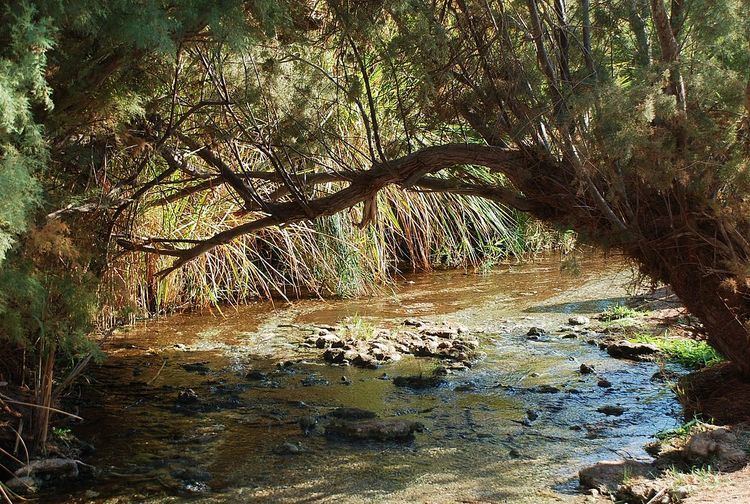 | ||
Einot Tzukim (Hebrew: עינות צוקים) (lit. "Cliff springs"), also known as Ein Feshkha, is a nature reserve and archaeological site on the northwestern shore of the Dead Sea, about three kilometers south of Qumran in Israel. It is named for a spring of brackish water in the area. The Einot Tzukim nature reserve consists of an open reserve with pools of mineral water for bathing surrounded by high foliage and another section that is closed to visitors to protect the native flora and fauna.
Contents
Nature reserve
The saline wetlands of Einot Tzukim are the only known place in the world where populations of Blue and Dead Sea killifish (Nevit Hula and Nevit Yam Hamelakh) live side by side. The Israel Nature and Parks Authority and the Israeli Ministry of Agriculture are constructing pools in the area to preserve these native fish. Two of the pools are complete and are now populated by tens of thousands of fish. Measures are also being taken to preserve the tilapia population.
Enot Tsukim is divided into three sections: the northern "closed reserve," the central "visitors reserve," and the southern "hidden reserve." The closed reserve is only open to scientists by special invitation. This section covers approximately 2,700 dunams. The 500-dunam visitors reserve features wading pools filled with natural spring water.
Due to ecological concerns, the hidden reserve is closed to the public apart from tours on Fridays.
Archaeology
Excavations at Einot Tzukim were conducted by Roland de Vaux of the Ecole Biblique in 1956 and 1958. Hirschfeld excavated the site in 2001. The earliest structure at the site, located south of the spring, was an Iron Age II fort, constructed at a similar time to the earliest structures at Qumran and down the Dead Sea coast.
The spring at Einot Tzukim is now located 100 meters south of the main building found by de Vaux and at least 3 meters lower. In ancient times a spring, now dried up, just north of the main building supplied water. This ancient spring being several meters higher suggests that it was sweet, not brackish. The complex is composed of a main building (24m by 18m) with central courtyard, an industrial installation with two plastered basins to its northeast and what appear to be stables to its west.
De Vaux showed that the Einot Tzukim complex was contemporary with the settlement at Qumran and theorized that they were inhabited by the same community and, while he dated traces to the period from 100 to 31 BCE, both Magness and Hirschfeld have concluded that the complex was Herodian, i.e. after 37 BCE. The entrance was through two doors, side-by-side, to the east. There is a staircase in the southeast corner of the building, showing that there was an upper story. A channel brings water from the spring through the wall to the north into a small rectangular tank on to each of the two basins. The purpose of this installation is unknown. It may have served as part of a tannery or for raising fish. More recent analyses suggest it may have been used in indigo manufacturing, date-wine preparation, date-honey production or opobalsam preparation.
